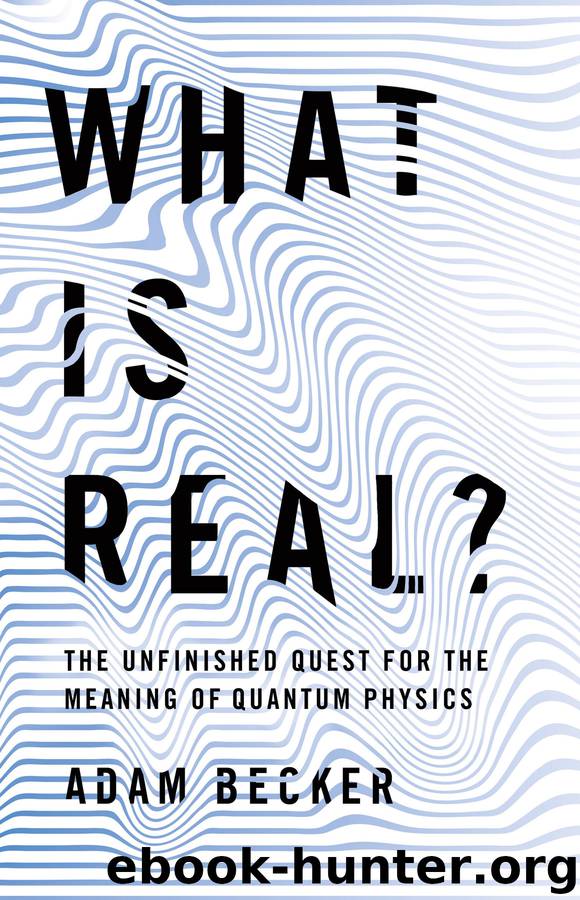What Is Real? by Adam Becker

Author:Adam Becker
Language: eng
Format: epub
Publisher: Basic Books
Published: 2018-03-20T04:00:00+00:00
On the other side of the Atlantic, a young German physicist named Dieter Zeh was having similar doubts about the Copenhagen interpretation. “It was a slow process, and not just a sudden thing,” he said later. “I always had these doubts, but of course I didn’t dare to draw the conclusion that these people are all nuts.” Thoughtful, humble, and unfailingly polite, Zeh had little in common with the loud and blustery Clauser, aside from a shared skepticism of Copenhagen. Clauser’s day-to-day work as an observational astrophysicist involved building and testing sensitive experimental equipment. Zeh, by contrast, was a theoretical nuclear physicist. His work involved detailed quantum calculations; he was very much at home with the abstract mathematics behind quantum physics. And these differences between the two men were also reflected in their ultimate aims. While Clauser was uncomfortable with quantum physics and wanted to prove it wrong in the laboratory, Zeh understood the theory intimately—and found something truly surprising lurking within it.
Zeh had been puzzling over a problem in nuclear physics, one in which an atomic nucleus was in a Schrödinger’s cat–like state of superposition, pointing in a multitude of directions at once. Meanwhile, the protons and neutrons within the nucleus were highly entangled with one another, so finding the position of just one of them would determine the positions of all the rest. “This made me think,” Zeh recalled. “I said, let’s assume that the universe is a closed system, like a nucleus. It was for me a very important step.” Zeh didn’t think that the universe was literally a single atomic nucleus. But he realized that the general idea—a system in a superposition, with its components strongly entangled—could explain how measurement works in quantum physics, without resorting to any of the tricks the Copenhagen interpretation used, like wave function collapse or a split between the physics of the small and the large. Treat a measurement device as a quantum system, and the act of measurement as a normal physical interaction, and quantum physics says that the measurement device will become strongly entangled with the thing it’s measuring—and the overall system of measuring-device-and-thing-being-measured will be in a Schrödinger’s cat state. But, Zeh realized, it went beyond that: the measuring device interacts with the experimenter, and everything else in the room, and eventually the entire universe—so when a small quantum system interacts strongly with a large object, ultimately, the entire universe ends up like Schrödinger’s cat, splitting into dead-cat and alive-cat “branches.” And the inhabitants of each branch of the universe only see one outcome: the dead cat or the living cat, depending on which branch they’re in. But the wave function never collapses, and the different branches of the universe are extraordinarily unlikely to interact. “If you make a measurement, you get an entanglement between the system and the apparatus and the observer,” Zeh said. “The observer sees only one component [of the Schrödinger’s cat state] and not the superposition of all the others. So, that solves the measurement problem.
Download
This site does not store any files on its server. We only index and link to content provided by other sites. Please contact the content providers to delete copyright contents if any and email us, we'll remove relevant links or contents immediately.
The Complete Stick Figure Physics Tutorials by Allen Sarah(7307)
Secrets of Antigravity Propulsion: Tesla, UFOs, and Classified Aerospace Technology by Ph.D. Paul A. Laviolette(5309)
Thing Explainer by Randall Munroe(3877)
The River of Consciousness by Oliver Sacks(3540)
The Order of Time by Carlo Rovelli(3145)
How To by Randall Munroe(3035)
A Brief History of Time by Stephen Hawking(2960)
I Live in the Future & Here's How It Works by Nick Bilton(2935)
The Great Unknown by Marcus du Sautoy(2647)
What If?: Serious Scientific Answers to Absurd Hypothetical Questions by Randall Munroe(2637)
Midnight in Chernobyl by Adam Higginbotham(2483)
Blockchain: Ultimate Step By Step Guide To Understanding Blockchain Technology, Bitcoin Creation, and the future of Money (Novice to Expert) by Keizer Söze(2445)
Networks: An Introduction by Newman Mark(2360)
The Meaning of it All by Richard Feynman(2300)
Easy Electronics by Charles Platt(2281)
The Tao of Physics by Fritjof Capra(2230)
Midnight in Chernobyl: The Untold Story of the World's Greatest Nuclear Disaster by Adam Higginbotham(2177)
When by Daniel H Pink(2083)
Introducing Relativity by Bruce Bassett(2077)
